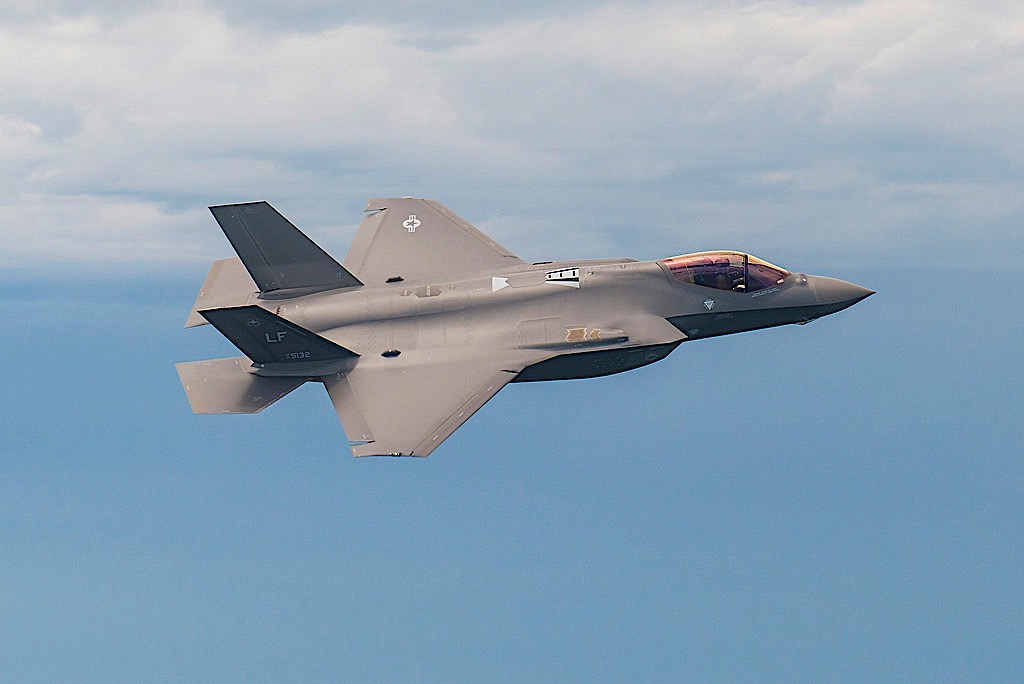
The U.S. Air Force has decided to move forward on Raytheon Technologies‘ Pratt & Whitney Engine Core Upgrade for the F-35 fighter and end the service’s Advanced Engine Transition Program. (Photo: Lockheed Martin)
The U.S. Air Force has decided to move forward on Raytheon Technologies‘ Pratt & Whitney Engine Core Upgrade (ECU) for the F-35 fighter and end the service’s Advanced Engine Transition Program (AETP), which received the Air Force-requested amount of $286 million last year.
The Air Force’s fiscal 2024 budget requests $245 million for ECU and increases research and development funding for an advanced engine for the Next Generation Air Dominance (NGAD) manned fighter.
Such NGAD advanced engine development—Next Generation Adaptive Propulsion (NGAP)—would receive $595 million in fiscal 2024, as opposed to $220 million appropriated by Congress last year, according to budget documents.
That $220 million appropriated for NGAP in fiscal 2023 was a nearly $153 million increase over the Air Force budget request (Defense Daily, Jan. 4).

Pratt & Whitney developed ECU, a block upgrade for the F135, with the objective of providing an affordable, low risk, and agile pathway to fielding meaningful propulsion capability for all F-35 customers. (Photo: Pratt & Whitney)
Five companies–General Electric, Pratt & Whitney, Boeing, Lockheed Martin, and Northrop Grumman–received contracts last year under an umbrella, $975 million effort for the prototype phase of NGAP.
Pratt & Whitney has said that it will be able to outfit 24 F-35 squadrons with ECU by 2030—seven squadrons in 2029 and 17 in 2030.
As part of AETP, General Electric proposed its XA100 Tri-Variant Adaptive (TVA) engine to accomodate the envisioned Block 4 weapons and other upgrades for the Lockheed Martin F-35.
Last October, 48 representatives urged DoD to invest in next generation, adaptive propulsion for fighters in a letter co-sponsored by Sens. Rob Portman (R-Ohio) and Sherrod Brown (D-Ohio) and Rep. Brad Wenstrup (R-Ohio).
In all, 13 of 16 Ohio representatives signed the letter.
General Electric’s GE Aviation subsidiary has its headquarters in Evendale, Ohio outside of Cincinnati.
GE has said that it began working with the F-35 Joint Program Office in the fall of 2021 on evaluating whether GE could alter the proposed XA100 for the U.S. Air Force’s AETP to fit on the U.S. Marine Corps F-35B.
“This [fiscal 2024] budget fails to consider rising geopolitical tensions and the need for revolutionary capabilitites that only the XA100 engine can provide by 2028,” GE said on March 13. The company said that continuing AETP would also acknowledge “the role competition can play in reducing past cost overruns.”
In addition, GE said that DoD has already spent $4 billion on AETP thus far and that ECU would not provide the improvements needed for the F-35 and provided by the XA100.
The company has said that it has verified $10 billion in savings for the XA100 through fuel efficiency, improved durability, and maintenance costs compared to the original program requirements
The $10 billion “is the net savings for AETP unique costs offset by fuel savings over the life of the program,” GE said. “This number was calculated as a contractual deliverable under AETP based on USAF provided assumptions. This is a conservative number and does not take into account savings that would be delivered through increased engine durability which reduces time to overhaul and unscheduled maintenance. Again, the XA100 delivers ready capabilities with real taxpayer lifetime savings, as our number is not calculated based on cost avoidance due to existing engine issues.”
GE said that it would advance development of the XA100 this year.
Since 2016, the Air Force has funded the AETP.
The F-35 program has said that while the XA100 TVA is based on the F-35A’s F135 engine the TVA would require an independent development program.
Air Force Secretary Frank Kendall said that the Air Force’s decision in fiscal 2024 to pursue ECU and end AETP for the F-35 was based on affordability and that the service may have pursued AETP for the fighter “if the [AETP development] cost had been lower.”
This article was originally published by Defense Daily, a sister publication of Avionics International. It has been edited. Read the original version here >>